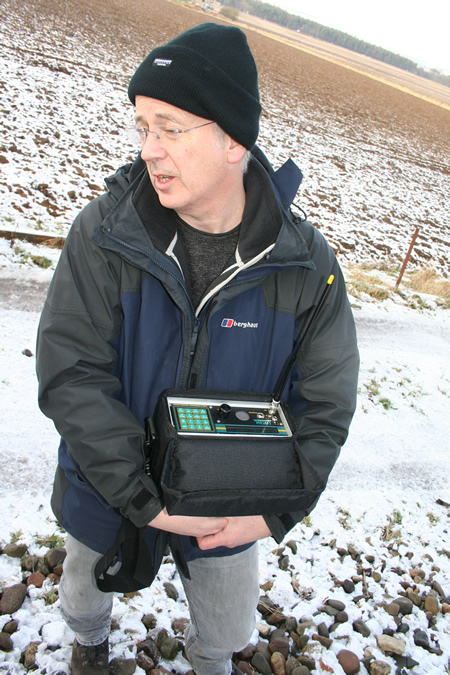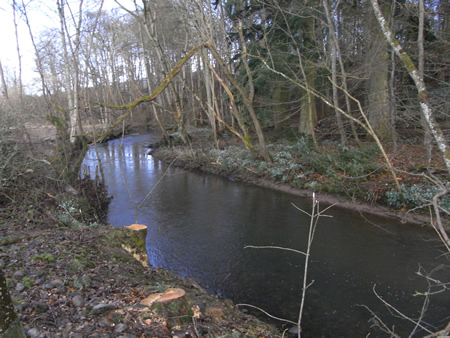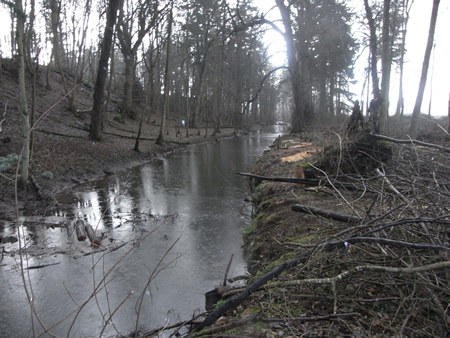These bulletin blogs represent news about Finavon and the South Esk, and my views as a riparian owner. They are not the views of any other organisation, nor are they designed to promote the interests of any individual or organisation other than Finavon Castle Water and factors affecting the fishery. Tony Andrews
I met Gordon and Julian, the scientists from the Marine Scotland office in Montrose, at the gate to FCW’s Milton Beat today, where they had been enjoying a day out of the office checking their receivers, replacing batteries etc. Their report to me on progress with the South Esk salmon tracking project was the first bit of output from the project.

Julian Maclean at the Haughs of Finavon with mobile radio tracking receiver for following returning salmon to their preferred spawning locations.
Usan nets now operating: The weather at sea over the last couple of weeks has been variable and some days the sea has been too rough to work the nets. However, catches have been steady, and MSS targets for tagging met. Yesterday (Thursday 8th of March) the Usan nets caught 16 salmon, a mixture of 3SW and 2SW fish. That is a good number to catch in the nets in early March and, although at present we have no idea of where these fish were going, or which river they ‘belong to’, a catch of this size at this time of year may start to give succour to the Pullars, who have long claimed that early spring socks are better than some have recently claimed.
Building the picture, piece by piece:Of course, one day’s catch does not get close to telling the full story, especially about the fragility or otherwise of populations from the different rivers exploited by the net fishery. What it does do however is to tell us that these unattributed multi sea winter (MSW) fish were present in quite respectable numbers very early in the year. One should speculate no further. That is the fact!
First South Esk salmon tracked:But we can go a little further than this because the tracking receiver at Bridge of Dun picked up a signal in the very early hours of Sunday morning showing that a salmon tagged at Usan had entered the South Esk. It was subsequently tracked at the Middle Kinnaird Hut, some two and a half miles upstream, but has not yet been picked up by a receiver upsttream of Kinnaird dyke.
What does this tell us? First, that the tracking methodology and technology works! Secondly, that at least one fish caught in the Usan nets was bound for the South Esk. Thirdly, there are no reports of fish being tracked in the Tay, and none so far on the North Esk.
Whilst we shouldn’t get too excited, I think it is fair to claim that this is a good starter, and that we can anticipate more news on the migration of returning adult salmon to the South Esk (and perhaps elsewhere) over the next few months.
TA 0n 9/3/2012
Postscripts:
9/3/2012 I wanted to add a note on another aspect of the way this project is being approached by the MSS team. Julian and Gordon told me about a big fish, almost certainly a 3SW hen salmon, which, after being caught and selected, responded “too quickly” to the anaesthetic they give to every fish before fitting a transmitter. They decided not to radio-tag this salmon because, although it would have been a most interesting fish to track to its spawning location, they felt that the risk of it not surviving was too high. The salmon was therefore returned safely to the sea after recvovering from its anaesthetic.
I very much like this sensitive approach to the tagging task. Both Julian and Gordon are keen to minimise the amount of handling each fish gets as it is anaethetised and then fitted with a radio transmitter (about the size of a gerkin). Rather than risk a fish, however interesting the data it might produce, they are adopting a cautious approach in order to maximise the data set from the project. This I feel is good solid science targeting core data, and deserves our support. TA
12/3/2012 I spoke with Gordon Smith this morning, one of the scientists in the MSS Montrose office. He confirmed that up to now 23 salmon have been tagged, of which about 50% are 3SW and 50% 2SW. Deciding whether thay have been at sea for two or three sea winters is done by reading scales from fish anaesthetised and tagged. Apart fom that analytical tool, the only other sampling is a small, almost untraceable, clip of the trailing edge of the adipose fin taken for DNA analysis. I say “untraceable” because I was curious to know how the MSS scientists would identify salmon already tagged and caught again in the Usan nets. In fact the sharp eyes of a scientist would be able to find any fish that had already been tagged, and thus avoid loading them up with another transmitter!
I asked Gordon how he thought the project is going, to which he said that if they had known in advance that by the 12th of March they would have successfully tagged 23 salmon they would have been well satisfied.
To summarise: one fish tracked into the South Esk as far as Kinnaird. No other fish reported from receivers elsewhere. Gordon and I agreed that until there is some fresh water in the rivers we are unlikely to see much movement upriver. TA on 12/3

